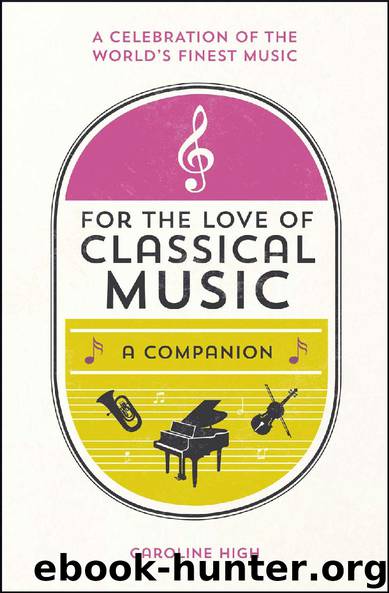For The Love of Classical Music by Caroline High

Author:Caroline High
Language: eng
Format: epub
Publisher: Summersdale Publisher
CLASSICAL CHUCKLES
How many conductors does it take to change a lightbulb?
No one knows because no one ever looks at them.
THE ORCHESTRA
‘There are two golden rules for an orchestra:
start together and finish together. The public
doesn’t give a damn what goes on in between.’
THOMAS BEECHAM
THE SYMPHONY ORCHESTRA
THE BASICS
The ancient Greek word orchestra meant the circular space in front of the stage reserved for performers. But gradually the word came to mean a group of musicians who played together in the said space.
There are usually between 80 and 100 players in a modern orchestra.
The orchestra is divided up into four sections: strings, woodwind, brass and percussion, and there is a principal player for each section.
STRING SECTION
The string section has the majority of players in a modern orchestra – around 60. Generally, there are:
16 (first and second) violins
14 violas
14 cellos
Ten double bass
The violins are divided up into first and second; the first violins usually play the tune, and the second violins, the harmony (see Glossary).
The principal player of the first violins is called the leader of the orchestra, and is second in command to the conductor.
Strings snippets
The violin first made an appearance in the mid 1500s, with the evolution of the symphony and the string quartet in the eighteenth century establishing its continued valuable position in classical music.
The violin, which has four strings, is made up of 80 separate parts, with pine or spruce being used for the front (or soundboard), and a hardwood such as maple used for the back.
The viola is the alto of the string section and is pitched a fifth below the violin. It is mainly played as a lower musical line underneath the violins, although it can be played as a solo instrument, for example in Hector Berlioz’s symphony Harold in Italy, which has a viola obbligato (an important solo instrumental part).
The cello’s proper name is ‘violincello’ but is always referred to in its abbreviated form. It is tuned one octave below the viola. At about four feet long, you’re unlikely to be able to tuck it under your chin, and that’s why it’s played with the body of the cello between the player’s legs.
The double bass is the big boy of the strings, measuring about six feet from top to toe, although, surprisingly, there’s no standard size. Its strings (gut or steel) are overwound to make it more manageable to play, and they are tuned to E, A, D and G; those of five strings to B, E, A, D and G.
GRACE NOTE
The bow of a stringed instrument is strung with hair from horses’ tails.
Download
This site does not store any files on its server. We only index and link to content provided by other sites. Please contact the content providers to delete copyright contents if any and email us, we'll remove relevant links or contents immediately.
The Cello Suites by Eric Siblin(916)
Hungarian by Hungarian(731)
Bach's Musical Universe by Christoph Wolff(658)
Franz Liszt by Saffle Michael(563)
Secret Lives of Great Composers by Elizabeth Lunday(546)
Stravinsky by Stephen Walsh(522)
Curious and Modern Inventions: Instrumental Music as Discovery in Galileo's Italy by Rebecca Cypess(518)
Music for Silenced Voices by Wendy Lesser(481)
The Complete Idiot's Guide to Classical Music by Sherman Robert(480)
Music In The Baroque Era - From Monteverdi To Bach by Manfred F. Bukofzer(466)
The Cambridge Companion to Stravinsky by Jonathan Cross(464)
The Beethoven Syndrome by Mark Evan Bonds(464)
The Romantic World of Puccini: A New Critical Appraisal of the Operas by Iris J. Arnesen(459)
Music for Life: 100 Works to Carry You Through by Fiona Maddocks(457)
Chopin's Piano by Paul Kildea(436)
Rachmaninoff's Complete Songs by Richard D. Sylvester(434)
The Detroit Symphony Orchestra by Harris Laurie Lanzen; Ganson Paul;(423)
Guide to Sonatas: Music for One or Two Instruments by Melvin Berger(416)
Dangerous Melodies by Jonathan Rosenberg(400)
